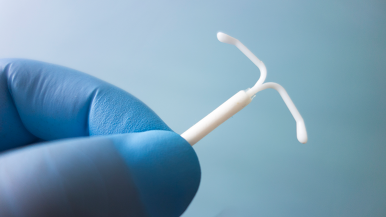Bleeding, intense cramping, even fainting: These are some of the experiences women are sharing across social media about IUDs — especially with the pain they feel during an insertion.
IUDs — short for intrauterine devices — have become an increasingly popular birth control option. But along with the growing use of the small T-shaped device, are increasing concerns from women about whether health care professionals are fully addressing patients’ pain.
This prompted the Centers for Disease Control and Prevention to update its guidelines regarding IUDs advising doctors to tell patients about the possible pain and discuss pain relief options before putting in an IUD.
While the CDC’s guidelines are new, Rush gynecologist Caroline Kuhn, MD, says counseling about pain management and expectations of any procedure are standard for most physicians.
“We do have things that can help mitigate the pain when inserting an IUD,” Kuhn says. “And depending on what the patient feels they want and need, we can help tailor and reduce some of that pain.”
So what should you expect when getting an IUD? Kuhn explains, and shares tips to help you prepare.
How painful is it really?
It depends, Kuhn says, because everyone’s pain tolerance is a bit different.
“It’s hard to know who’s going to have more or less pain when having an IUD inserted,” she says. “Which is why it’s important to have a visit with your provider beforehand to come up with a specific plan for pain and anxiety management on the day of the insertion.”
There are three parts to the procedure that can typically cause pain, Kuhn says. They include:
- Straightening the cervix: Your doctor will use a tool called a tenaculum to hold and straighten the cervix. This helps to make sure the IUD is placed correctly inside the uterus.
- Measuring the uterus: Your doctor will measure the length of the uterus with a small device called a sound. This tool goes through the cervix to the top of the uterus to find out its size.
- Placing the IUD: Finally, the IUD is placed at the top of the uterus. The strings are then trimmed, and the instruments are removed.
The benefits of IUDs
Kuhn says that the pain shouldn’t stop you from considering an IUD, the third most common birth control method in the U.S. after tubal ligation and the oral contraceptive pill.
Hormonal IUDs have a variety of benefits, she says, such as shorter menstrual periods, lighter cramping, and not having to worry about an unintended pregnancy. They can also be used to treat endometriosis, anemia, and even prevent endometrial pre-cancer and cancer.
“IUDs are as effective as getting your tubes tied in terms of prevention of pregnancy. They’re really an investment that can last for up to eight to 10 years. And working with your doctor ahead of time can help make the experience more comfortable for you.”
What you can do to prepare
If you’re considering an IUD, Kuhn suggests setting up a contraception counseling visit before an IUD insertion. At this appointment, your doctor will review your options, including non-IUD choices, discuss the side effects and how long IUDs last and explain the insertion process.
She adds that this is also an important time for you to express — and for your doctor to understand — your pain tolerance and any past experiences with gynecologic care. They might include previous diagnoses or pregnancies, a history of trauma, as well as any anxiety surrounding the procedure.
Kuhn shares ways you can help limit your pain during the insertion:
- Time your IUD insertion procedure to around your period. “The cervix is more open when you're on your period, so there’s less sensitivity to pain,” Kuhn says. If the timing does not work out, it is still possible to have an IUD placed at any time in the cycle.
- Medications. Take 600-800 mg of ibuprofen before your appointment. “Ibuprofen is often recommended because it’s a non-steroidal, anti-inflammatory drug that works specifically well on uterine tissue,” Kuhn says. Other options to ask your doctor about include a lidocaine numbing ointment or a lidocaine injection for the cervix, which can also decrease some of the pain. “There are several networks of nerves supplying the uterus and cervix, which makes it difficult to completely numb the entire area with local anesthetics and eliminate all pain during an IUD insertion,” Kuhn says. “But studies have shown that it may help with some of the pain during insertion.” And depending on your situation, your doctor might also suggest an anti-anxiety medication before your insertion appointment.
- Heat packs. Ask your doctor if a heat pack is available. Place this over your pelvis during the procedure to help ease the pain.
Other tips to prepare for the insertion procedure include:
- Eating a meal before you come in.
- Making sure you are hydrated.
- Wearing comfy clothes.
- Bringing a light snack for after the procedure.
- Bringing a book or your phone to watch videos or listen to music. “This can take your mind off the process,” Kuhn says.
- Bringing or ask your doctor for pads for potential spotting afterwards.
- Clearing your schedule for the day. “The most painful part is during the 30 seconds when the IUD is being placed,” Kuhn says. “But you may have some mild period-like cramping afterward and want to just be on the couch with a heating pack.”
To learn more about IUDs, or other forms of birth control, make an appointment with a gynecologist today.




